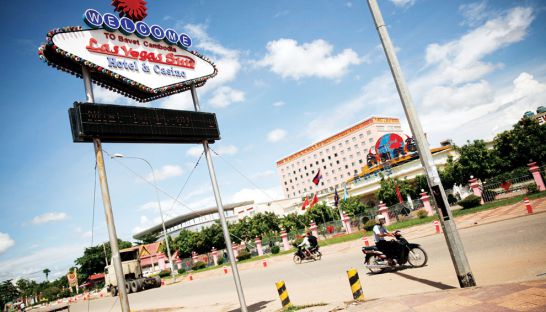Bavet’s state of expensive languish no longer a recreational success
Bavet’s state of expensive languish no longer a recreational success
With the border city being peppered with ‘for sale’ and ‘for rent’ signs, it seems as if real estate activity in Bavet has seen better days.

For the past decade, the city’s property pool has remained stagnant. Most notably, Bavet’s hotels and casinos are bearing the brunt of inactivity while other construction projects have taken a more dwindling tone.
Pen Phearun, head of administration of Bavet’s city hall, said, “In the last five years, Bavet has been lacking major buying, selling, and construction activity.” On a lighter note, “If we’re talking about labour activity in garment factories, and tyre factories, it can be said that it’s bustling like a well-oiled machine.”
Besides these garment and tyre factories that have managed to remain untouched, the upcoming construction of a factory manufacturing spare parts and computers will commence in 2017, according to Phearun.
While declining to comment on the exact amount of investment pumped into this factory, Phearun disclosed that the investors own a 2-hectare piece of land within the Manhattan special economic zone (SEZ).
“Currently, there are 50,000 people residing in Bavet – there are 33,301 factory workers, working in 52 factories, most of which are garment factories,” noted Phearun. As for special economic zones, the most active ones are the Manhattan and Tai Seng SEZs.
Sanh Sakhun, district chief of Bavet city, said, “In regards to the buying and selling of properties, it has been absolutely quiet in Bavet. It’s so much different from before. In the past, Bavet city was bustling with merchants coming to buy and sell land and property; unfortunately, after the tragic accident of Hok Lundy, most of the activity just ceased.”
Hok Lundy, the National Police Commissioner of Cambodia from 1994 to 2008, was a native of Bavet and had contributed to much of the city’s real estate growth and prosperity before his death in 2008.
With entertainment centres also failing to attract as many patrons as before, Phearun said, “Recently, we have heard complaints from some hotel and casino owners saying that there have been very few guests coming to stay and entertain themselves there. As a direct result of this, many owners of such establishments have resigned to reducing the number of their staffs.”
Keoung, manager of the Las Vegas Sun Hotel & Casino in Bavet city, refused to speak with Post Property.
Nevertheless, Ho Vandy, secretary general of Cambodia Association of Travel Agents (CATAs), noted that it was a normal occurrence for such recreational establishments to scale back after having enjoyed a pinnacle of success.Shedding some light on the touristic patterns in Bavet, Vandy explained: “As a city located along the Cambodian-Vietnam border, it used to experience success from the flow of Vietnamese tourists in the past. [This] has now arrived at a stand-still due to the fact that these visitors had become tired of the repetitive recreational activities.
“No one comes to a place to be entertained only by casinos; therefore, the government and investors should think of new ways to entertain tourists here by coming up with fresh ideas for recreational activities in order to attract tourists, as well as foreign traders.”
Keeping sanguine, Bavet native Kim Heang, head of Cambodian Valuers and Estate Agents Association, said, “Bavet city is different from other cities, especially in the real estate aspect; even though the activity is almost nonexistent, the value of land property remains high and unfaltering due to the city’s industrial potential in the present and the future.”
“Land property situated along the big roads, especially the ones near National Road 1, had their value increased from $200 to $400 per square metre,” said Heang.
He added, “As for rice fields that are located far from national roads, where factories can be built on; they are valued at $30 per square metre.”
“However, Bavet residents are still selling their lands based on the walking metre method – meaning that if we’re talking about the lands along the national roads – for a plot of land, a walking metre can be valued as high as $10,000 to $15,000 according to the length of the plot.”













